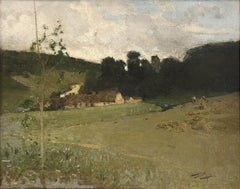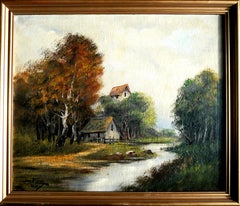Pierre Eugene Montezin Art
to
2
2
2
2
Overall Height
to
Overall Width
to
1
1
1
1
2
3
10
9
4
3
2
1
1
1
1
Artist: Pierre Eugene Montezin
Dealer: Galerie L'Angelus
Paysage à Muzy sur Avre (Normandie)
By Pierre Eugène Montezin
Located in Barbizon, FR
Oil on canvas, signed in the bottom right corner
His father was a lace designer and set him up to work in adecoration workshop. Later, he became heavily influenced by impressionist ...
Category
Early 20th Century Barbizon School Pierre Eugene Montezin Art
Materials
Canvas, Oil
Le verger
By Pierre Eugène Montezin
Located in Barbizon, FR
Gouache on paper, signed in the bottom left corner
His father was a lace designer and set him up to work in adecoration workshop. Later, he became heavily influenced by impressionis...
Category
Early 20th Century Barbizon School Pierre Eugene Montezin Art
Materials
Paper, Gouache
Related Items
French Barbizon school Barn landscape - Oil painting Signed
Located in Zofingen, AG
Landscape from 1892
Typical farm with thatched roof from Brittany from Henri Catrou (1855-1938). He was a "plein air" painter from Barbizon school, who the most famous painters wer...
Category
1890s Barbizon School Pierre Eugene Montezin Art
Materials
Oil
Oil Painting 19th Century Cows Landscape Barbizon
By Antonio Cortes
Located in Saint-Ouen, FR
CORTES Antonio (1827-1908)
Cows to pasture
Oil on canvas signed lower left
Old frame gilded with leaves
Dim canvas : 54 X 65 cm
Dim frame: 70 x 86 cm...
Category
1860s Barbizon School Pierre Eugene Montezin Art
Materials
Oil
H 27.56 in W 33.86 in D 2.37 in
French Barbizon School oil painting, Sunset over a river landscape impressionist
Located in Antwerp, BE
Large French Barbizon riverscape "Sunset over a river" by Henry Jacques Delpy
This peaceful barbizon riverscape depicts a sunset illuminating the sky and covering the whole scenery ...
Category
19th Century Barbizon School Pierre Eugene Montezin Art
Materials
Canvas, Oil
Antique Barbizon School Oil Painting Original Gold Frame Rich Colors Fall
Located in Buffalo, NY
Original Barbizon school painting in an original period frame.
Framed 24 x 18
Unframed 18 x 12
Category
19th Century Barbizon School Pierre Eugene Montezin Art
Materials
Oil, Canvas
1930's French Barbizon School View of a Chateau in a Park Landscape
Located in Cotignac, FR
French Barbizon School watercolour on paper view of a chateau in a park by Henri Clamen. The painting is not signed but was acquired from the artist's atelier with other signed paint...
Category
Early 20th Century Barbizon School Pierre Eugene Montezin Art
Materials
Paper, Watercolor
No Reserve
H 6.3 in W 9.85 in
Mother dog and her puppies, 19th Century French Barbizonf armhouse painting
Located in Norwich, GB
An charming 19th century dog painting depicting a mother dogue and her exuberant topsy turvy pups by the farmhouse barns or cowsheds , with a young child given them a fuss!
Dating from ca 1860-70, the oil on canvas is unsigned, but bears on the verso a rather special stamp from colour and artists supplies merchant Paul Durand-Ruel (1831-1922). Paul Durand-Ruel is known as the legendary art dealer who launched, almost single handedly, the Impressionist movement. He represented Monet, Pissarro, Sisley, Renoir in his Paris, London and New York Galleries.
Like his father Jean Marie Durand, Durand Ruel had started as both a merchant of art supplies, and dealer. Often, these two activities overlapped, as he would supply cash strapped artists who left paintings as security. Paul Durand Ruel was one of the first to discover Barbizon artist...
Category
1860s Barbizon School Pierre Eugene Montezin Art
Materials
Canvas, Oil
H 27.17 in W 31.89 in D 0.4 in
French School 19th century, Animated dune landscape, oil on panel
Located in Paris, FR
French School mid 19th Century
Animated dune landscape,
oil on cardboard panel
12.4 x 29.8 cm
bears a small inscription "Escoublac" on the lower right, not visible under the actual ...
Category
1850s Barbizon School Pierre Eugene Montezin Art
Materials
Oil
A Winter Wonderland, Barbizon School Snowscape.
Located in Cotignac, FR
An oil on panel view of a winter snow scene by Boggio. The painting is signed bottom right.
A charming view of a snow scene, a river running by a bank heavy with snow.
Category
Mid-20th Century Barbizon School Pierre Eugene Montezin Art
Materials
Oil, Board
River Cottage 1849/ Barbizon landscape heralding Impressionism Jongkind's friend
By Henri Sieurac
Located in Norwich, GB
A wonderful view of a river landscape with a rustic cottage and pollarded trees by Henri Sieurac. It isa rare, early and very fresh landscape by this Parisian artist which may well have been painted in the countryside around Barbizon, near the river Loing.
Henry Sieurac had studied with his father, François Joseph Sieurac , and of Paul Delaroche...
Category
1840s Barbizon School Pierre Eugene Montezin Art
Materials
Oil, Canvas
H 13.39 in W 16.54 in D 1.19 in
'Forest at Fountainbleau' Original Oil Painting on Board from Barbizon School
Located in Milwaukee, WI
This small painting of the Forest at Fontainebleau in France is an excellent example of the Barbizon School. The Barbizon School of artists were working in France roughly between 182...
Category
Mid-19th Century Barbizon School Pierre Eugene Montezin Art
Materials
Oil, Board
H 19.63 in W 16.63 in D 2.75 in
The Marshlands
Located in Storrs, CT
A marsh landscape in the style of Max Weyl. Oil on board measures 12 3/4 x 23 5/8; frame dimensions measure 16 1/4 x 27 x 1 1/4. Unsigned. Housed in a gold-to...
Category
20th Century Barbizon School Pierre Eugene Montezin Art
Materials
Oil
The Forest, Large Barbizon School, Oil on Canvas Wooded Landscape
By Emile Roux-Fabre
Located in Cotignac, FR
A French Barbizon School oil on canvas forest view by Emile Roux-Fabre. The painting is signed and dated bottom left with a dedication.
A charming view of forest glade leading out to a valley landscape beyond. The artist has captured the magic feeling of the cool forest shade against the sunshine of the landscape beyond. The texture of the bark on the silver birch trees, the contrast of the leaves on the trees all framing the perspective to the view beyond. An extremely accomplished and atmospheric painting.
The Barbizon school of painters was part of an art movement towards Realism in art, which arose in the context of the dominant Romantic Movement of the time. The Barbizon school was active roughly from 1830 through 1870. It takes its name from the village of Barbizon, France, on the edge of the Forest of Fontainebleau, where many of the artists gathered. Most of their works were landscape paintings, but several of them also painted landscapes with farmworkers, and genre scenes of village life. Some of the most prominent features of this school are its tonal qualities, colour, loose brushwork, and softness of form.
The leaders of the Barbizon school were: Théodore Rousseau, Charles-François Daubigny, Jules Dupré, Constant Troyon, Charles Jacque, and Narcisse Virgilio Díaz. Jean-François Millet lived in Barbizon from 1849, but his interest in figures with a landscape backdrop sets him rather apart from the others. Jean-Baptiste-Camille Corot was the earliest on the scene, first painting in the forest in 1829, but his work has a poetic and literary quality which sets him somewhat apart. Other artists associated with the school, often pupils of the main group, include: Henri Harpignies, Albert Charpin, François-Louis Français and Émile van Marcke.
In 1824 the Salon de Paris exhibited works of John Constable, an English painter. His rural scenes influenced some of the younger artists of the time, moving them to abandon formalism and to draw inspiration directly from nature. Natural scenes became the subjects of their paintings rather than mere backdrops to dramatic events. During the Revolutions of 1848 artists gathered at Barbizon to follow Constable's ideas, making nature the subject of their paintings. The French landscape became a major theme of the Barbizon painters.
Millet extended the idea from landscape to figures — peasant figures, scenes of peasant life, and work in the fields. In The Gleaners (1857), for example, Millet portrays three peasant women working at the harvest. Gleaners are poor people who are permitted to gather the remains after the owners of the field complete the main harvest. The owners (portrayed as wealthy) and their laborers are seen in the back of the painting. Millet shifted the focus and the subject matter from the rich and prominent to those at the bottom of the social ladders. To emphasize their anonymity and marginalized position, he hid their faces. The women's bowed bodies represent their everyday hard work.
In the spring of 1829, Jean-Baptiste-Camille Corot came to Barbizon to paint in the Forest of Fontainebleau, he had first painted in the forest at Chailly in 1822. He returned to Barbizon in the autumn of 1830 and in the summer of 1831, where he made drawings and oil studies, from which he made a painting intended for the Salon of 1830; "View of the Forest of Fontainebleau'" (now in the National Gallery in Washington) and, for the salon of 1831, another "View of the Forest of Fontainebleau"'. While there he met the members of the Barbizon school: Théodore Rousseau, Paul Huet, Constant Troyon, Jean-François Millet, and the young Charles-François Daubigny.
During the late 1860s, the Barbizon painters attracted the attention of a younger generation of French artists studying in Paris. Several of those artists visited Fontainebleau Forest to paint the landscape, including Claude Monet, Pierre-Auguste Renoir, Alfred Sisley and Frédéric Bazille. In the 1870s those artists, among others, developed the art movement called Impressionism and practiced 'plein air' painting. In contrast, the main members of the school made drawings and sketches on the spot, but painted back in their studios.
The Post-Impressionist painter Vincent Van Gogh studied and copied several of the Barbizon painters as well, including 21 copies of paintings by Millet. He copied Millet more than any other artist. He also did three paintings in Daubigny's Garden.
The Barbizon painters also had a profound impact on landscape painting in the United States. This included the development of the American Barbizon school by William Morris Hunt. Several artists who were also in, or contemporary to, the Hudson River School studied Barbizon paintings for their loose brushwork and emotional impact. A notable example is George Inness, who sought to emulate the works of Rousseau. Paintings from the Barbizon school also influenced landscape painting in California. The artist Percy Gray...
Category
Early 20th Century Barbizon School Pierre Eugene Montezin Art
Materials
Canvas, Oil
H 24.02 in W 20.08 in D 0.79 in
Pierre Eugene Montezin art for sale on 1stDibs.
Find a wide variety of authentic Pierre Eugene Montezin art available for sale on 1stDibs. You can also browse by medium to find art by Pierre Eugene Montezin in paint, canvas, fabric and more. Much of the original work by this artist or collective was created during the 20th century and is mostly associated with the Impressionist style. Not every interior allows for large Pierre Eugene Montezin art, so small editions measuring 25 inches across are available. Customers who are interested in this artist might also find the work of Leon Richet, Achille-Émile Othon Friesz, and Emile Godchaux. Pierre Eugene Montezin art prices can differ depending upon medium, time period and other attributes. On 1stDibs, the price for these items starts at $7,592 and tops out at $35,925, while the average work can sell for $28,872.



